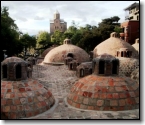|
Tbilisi - a cultural crucible
Tbilisi was founded in the 5th century by king Vakhtang Gorgasali (AD 446-502). The legend says that once the king went hunting, he wounded a pheasant and sent his falcon in pursuit. After a long search he found both birds boiled in a hot spring. The king decided that this should be the place of the new capital, and inspired by the warm spring he named the city Tbilisi derived from "tbili", the Georgian word for "warm".
Located strategically on the crossroads between Europe and Asia, Tbilisi emerged as a significant industrial, cul- tural and social center. Through history Tbilisi has often been location for rivalry between different conquerors.
Tbilisi has always had a population with different cultural, religious and ethnic background. Especially in the old district of Tbilisi you will find Armenians, Azerbaijans, Russians, Greek, Kurds and Georgians living side by side, practicing their religions and traditions. Tbilisi is one of the cities in the world where synagogue and mosque are situated close to each other.
In Tbilisi today you can easily experience the contrast between old and local traditions on the one side, and modern international influence on the other. This diversity creates a fascinating atmosphere with a city very much alive. At the same time the contrasts may also give rise to opposite interests. There is political will to restore and preserve the old part of Tbilisi, with the narrow streets, wooden houses and traditional architecture. At the same time modern commercial interests and urbanized lifestyle demands different environment with fancy restaurants, cafes and night life. This challenges the authentic atmos- phere in parts of the old city, leaving restored buildings and architecture without the initial atmosphere and soul. There are other parts of the old city, however, where the combination of restoration and maintenance of tradition, demography and local atmosphere is successful.
This contrast between new and old, between tradition and modern life style is literally visible at every corner and street. You may find the fanciest cafe and the most traditional Georgian restaurant side by side. In one moment you may see youngsters putting all their efforts into adapting a completely western style of life, only for in the next minute to see people in national customs dedicated to the Georgian song- and dance-tradition. You may walk in old narrow streets exploring medieval fortresses and churches as a direct witness of old tradition and culture. At the same time you can experience monumental architecture from the Soviet-time, as well as modern monuments and landmarks from the latest decade.
|
|
The sulfur baths are located in the old part of the city. They were built in the 17th century and the water can reach 47°C. “A great sense of freedom and well-being permeated me. All my tiredness had gone and I felt strong enough to lift a mountain” – Alexandre Dumas, after one of his visits to the sulfur baths.
Narikala Fortress (4th century) built on a hill between the sulfur baths and the botanic garden is overlooking Tbilisi and Mtkvari river. The fortress has been expanded several times through history, and part of it was damaged in an earthquake in the 19th century.
Sameba, the Holy Trinity Cathedral of Tbilisi is the main cathedral of the Georgian Orthodox Church. It was constructed from 1995 to 2004 and is the third biggest Eastern Orthodox Cathedral in the World.
Anchiskhati Church (6th century), a basilica, is the oldest church in Tbilisi. It was dedicated to Virgin Mary, but was renamed Anchiskhati in the 17th century.
Sioni Cathedral (7th century) is named after the mountain of Zion in Jerusalem. It houses the cross of St. Nino, and is accordingly considered as one of the most sacred places in Georgia.
Metekhi Church (13th century) is accompanied by the statue of king Vakhtang Gorgasali. During the regime of the Tsar the Metekhi Church housed a prison, and in Soviet times the church was used as a theatre.
The National Museum of History houses a unique collection of pre-Christian gold artifacts and jewelry, and the national collections of archaeology, history and ethnography.
The National Art Museum houses a treasury of medieval Christian art such as jeweled icons, inlaid crosses and cloisonné enamelwork. One can also find collections of Georgian, European and Oriental art.
Open-Air Museum of Georgian Folk Architecture houses original homesteads being brought from all over Georgia and restored. Here one can get an insight of the old rural life in Georgia.
Mtatsminda Pantheon is located on the way to the top of Mtatsminda hill, where you will approach the St. David Church and the surrounding churchyard. Here, some of the most prominent writers, artists, scholars, and national heroes of Georgia are buried.
|

Tbilisi by night. Photo: Goksan Akan © all rights reserved.
|


The sulfur baths in old Tbilisi.
Photo: Svend Waage © all rights reserved
|

Tbilisi - in the evening. Photo: Levan Chkhatarashvili © all rights reserved
|

Tbilisi in winter-time. Photo: Levan Chkhatarashvili © all rights reserved
|
| Facts Tbilisi:
Established:
Mayor:
City area:
Highest elevat.:
Lowest elevat.:
City population:
|
479 AD
G. Ugulava
726 sq.km
770 m
380 m
1,152,500
|
|
|













